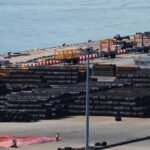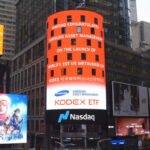SK Group Chairman Chey Tae-won (Courtesy of SK Group)
Nvidia Corp.’s Chief Executive Jensen Huang has asked SK Group Chairman Chey Tae-won to supply 12-layer HBM4 chips, the most advanced AI chips yet to be launched, six months earlier than SK’s schedule of early 2026, Chey said on Monday.
“When I met Jensen Huang, he asked to bring forward the supply of HBM4 by six months,” he said in a keynote speech for SK AI Summit 2024.
“And I looked at SK Hynix CEO Kwak Noh-jung and asked if it’s possible. He said he will try his best [to meet the request].
SK Hynix planed to deliver 12-layer HBM4 to the world’s largest AI chip designer in the first half of 2026, about one year after launching 16-layer HBM3E products in the first half of 2025.
Chey did not elaborate further on his recent meeting with Huang.
“Based on our simulation results, the 16-layer [HBM3E] products showed 18% improvement in learning performance and 32% improvement in inference performance, compared with the 12-layer HBM3E chips,” said SK Hynix CEO Kwak in the SK Group’s annual AI summit.
Currently, 12-layer HBM3E is its most advanced AI chips. It mass-produced the products last month for the first time in the industry for shipment later this year.
In March, SK Hynix became the industry’s first supplier of eight-layer HBM3E to Nvidia.
Nvidia Corp.’s Chief Executive Jensen Huang (Courtesy of AP)
IN COLLABORATION WITH TSMC FOR HBM4
The world’s No. 2 memory chipmaker has been cementing its top position in the market of HBM ahead of Samsung Electronics Co., the memory chip leader.
To develop HBM4 models, SK Hynix is teaming up with TSMC, the world’s No. 1 chip foundry company.
Kwak said it will adopt TSMC’s advanced logic process for HBM4’s base die. SK Hynix has used proprietary technology to make base dies up to HBM3E.
HBM is made by stacking a core DRAM die on top of a base die. The base die is connected to the GPU, which controls HBM chips.
SK Hynix is said to prepare for the launch of HBM5 and HBM5E in 2028.
SK Hynix’s 12-layer 36 GB HBM3E (Courtesy of SK Hynix)
NEW BONDING TECHNOLOGY FOR 16-LAYER HBM3E
For 16-layer HBM3E products, SK Hynix will apply advanced MR-MUF technology as it did for 12-layer HBM3 chips.
MR-MUF, used to attach semiconductor chips to circuits, reduces chip stacking pressure and cut the pressing time. SK Hynix is also developing hybrid bonding technology as a backup for MR-MUF, said Kwak.
NAND FLASH
In the NAND flash segment, SK Hynix is developing LPDDR5 and LPDDR6, using the 1c, or 10 nm-class process technology, which it unveiled in August, according to Kwak.
LPDDR stands for low-power double data rate and is commonly used in mobile devices.
SOLID STATE DRIVES
QLC refers to NAND flash with each storage cell capable of recording four bits and it allows more data to be stored in the same space, compared with other NAND flash chips.
His remarks came as SK Hynix is talks with Tesla Inc. at the US electric vehicle giant’s request for a possible 1 trillion won ($725 million) order of eSSDs, which industry sources confirmed last month.
By Jeong-Soo Hwang
hjs@hankyung.com
Yeonhee Kim edited this article.













